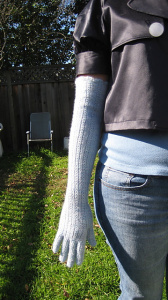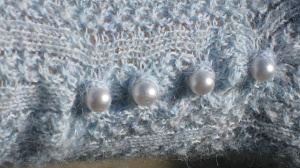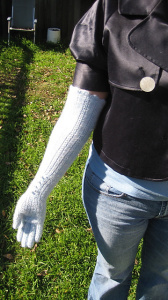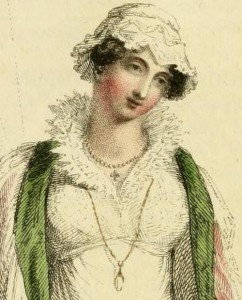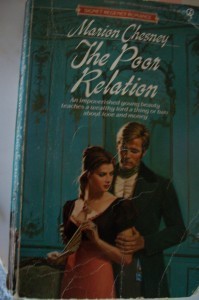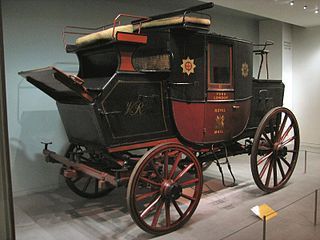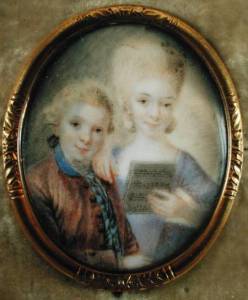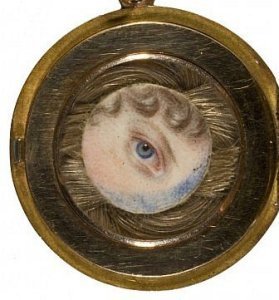Vanessa Riley's Blog, page 300
May 14, 2015
Knit lace evening gloves
Camy here! Lately I bought a hand-made Regency-style dress from my friend and Steampunk author, Shelley Adina, (it was a steal because she didn’t want it anymore) and so now I’ve been looking for accessories. (I’ll post pics of the dress soon!)
I realized that the blue dress is perfect for some lacy gloves I had made for myself a while ago. Actually, I originally made these gloves because Shelley had wanted opera gloves (designated “16-button gloves” even though there aren’t actually 16 buttons on the gloves) for when she goes Regency dancing, and I made my gloves as a test run before making Shelley’s.
These are a pale blue lace-weight alpaca yarn, although the original pattern called for crochet cotton. I also had to extrapolate a bit to extend the gloves beyond my elbow.
The gloves have pearl buttons at the wrist because Shelley had requested that, for ease of removing the hand portion when she has to eat. I found out later that the button slit is actually Victorian, and not Regency, but it’s extremely practical, don’t you think?
I’m rather proud of these gloves because they’re just so pretty!  I’m also so excited that they’re light blue, which matches the gown I just bought!
I’m also so excited that they’re light blue, which matches the gown I just bought!
If you’re on Ravelry, here’s the link to my project page.
Do any of you own Regency style gowns? Where do you get your accessories, or how do you make them?
May 5, 2015
When Is a Dress Not Just a Dress ~ Regency Fashion Explained
If you’ve ever read a Regency-set novel, you’ve no doubt run across a description of the heroine’s clothing. It’s one of those things we do. But have you ever stopped to wonder what makes an afternoon dress different from a carriage dress? Or a ball gown different from a dinner gown?
Here is a rundown of a few of the qualities that make a Regency dress fit for the proper occasion.
Morning dresses were used for just that. Morning. They weren’t meant for company or for going out. They were the yoga pants of Regency England. They were plain, unadorned, and frequently made of thinner, cheaper materials than a woman’s other clothes. Silhouette-wise, morning dresses were the same as any other day dress, though they were replaced less frequently given that no one cared whether or not their morning dress was fashionable.
Often times, an old afternoon dress might have the trim salvaged off of it before being used as a morning dress.
Afternoon Dress
Which then does beg the question of what makes an Afternoon Dress.
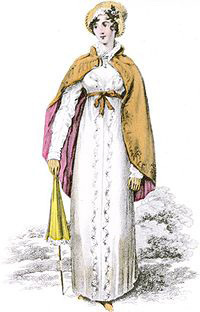 Afternoon dresses were meant to be seen. Afternoons were for going visiting or walking in the park. As these were still day dresses, they had high necklines and full length sleeves. They would, however, been trimmed and fitted to the best of a lady’s fashion ability.
Afternoon dresses were meant to be seen. Afternoons were for going visiting or walking in the park. As these were still day dresses, they had high necklines and full length sleeves. They would, however, been trimmed and fitted to the best of a lady’s fashion ability.
There were several types of afternoon dresses as there were several types of activities one could participate in during the afternoon.
Walking or Promenade Dress
Often the most decorative of the afternoon dresses, a walking dress was for strolling among the masses. Because they were meant to be noticed, care was taken to make sure they were flattering and impressive.
They weren’t, however, always practical since they followed the fashion of the day like everything else, including when it came to the length of the train.
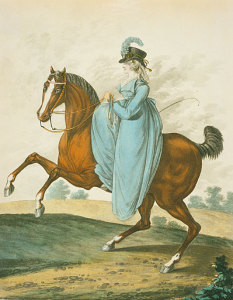 Carriage or Traveling Dress
Carriage or Traveling Dress
Carriage dresses were made of heavier fabrics, intended to put up with the stress of traveling by coach for long periods of time. The cotton muslin frequently used in walking dresses was prone to wrinkle. Carriage dresses were also less trimmed, since those could get crushed while traveling, particularly if your coach was full of companions.
Riding Habits
Riding habits were very sturdy, very simple, and very modest. They would have very full skirts to drape over the lady’s legs while riding side saddle.
Evening Dress
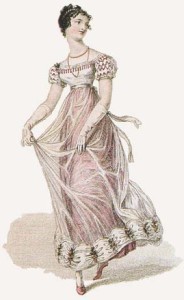 Evening dresses were the finest dresses in a lady’s wardrobe. The fabrics were thinner than the afternoon dress but were also much finer. Silks, satins, light taffetas, and very fine muslins were the fabrics of choice. Sleeves were frequently shorter and bodices were cut lower.
Evening dresses were the finest dresses in a lady’s wardrobe. The fabrics were thinner than the afternoon dress but were also much finer. Silks, satins, light taffetas, and very fine muslins were the fabrics of choice. Sleeves were frequently shorter and bodices were cut lower.
The different types of evening dress were indicated more by the level of embellishment than by the style. A lady’s ball gowns would be trimmed and embroidered to the utmost fashion, with the intention of catching the light as well as the gentleman. Many ball gowns were actually two gowns, with a sheerer gown worn over another. The bottom gown was sometimes colored and the top layer might only fall 3/4 of the way down the skirt, allowing the embellished hem of the underdress to show.
Opera gowns and dinner dresses were, by comparison, a bit simpler. They were still made of fine fabrics, still cut to show off more than a day dress, but were not intended to be quite as impressive as the ball gown.
Court Gowns
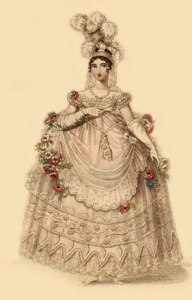 Court gowns were worn for the very special and rare occasion that a young lady went to the royal court. These gowns were a throwback to a bygone era, forgetting fashion entirely in the name of tradition. Wide, hooped skirts, long trains, and overly elaborate hair decorations ruled the court.
Court gowns were worn for the very special and rare occasion that a young lady went to the royal court. These gowns were a throwback to a bygone era, forgetting fashion entirely in the name of tradition. Wide, hooped skirts, long trains, and overly elaborate hair decorations ruled the court.
When people tried to mix these traditions with modern fashions you ended up with some very silly looking high-waisted gowns with elaborate bell-like skirts.
With all these dresses, it’s a wonder that Regency ladies ever got anything done besides changing their clothes.
April 30, 2015
Blast from the Past: Marion Chesney’s Regency novels
Hi all, Susan Karsten here!
…Back from an absence of about four months (that pesky tax job). Since I enjoy Camy’s posts on older regency books so much, I am bringing you info about a book, and its author, and telling you about her extensive and delicious back-list of regency reading fun (over 90 titles). If the author Marion Chesney is not familiar to you — get thee to a bookstore — or library in this case — since she isn’t (boo-hoo) writing regencies anymore.
No, she now only writes fabulously popular cozy mysteries now and you may know her as M.C. Beaton. However, her regencies are GREAT, and with some digging, are still available to the avid fan. She’s got some of her backlist out as e-books lately, too.
Chesney’s debut (writing under her own name) book, which I happen to own, is “The Poor Relation.” Heroine and former debutante Amaryllis Duvane’s fortunes have sunk low and she is reduced to the status of serving her wealthier relatives. Her past love, the Marquess of Merechester, shows up to court one of these wicked stepsister types, and the drama begins.
I’ll happily admit to being a huge fan of Chesney, in all her genres. But the chance to read one of her first efforts makes me admire her career trajectory even more. As one familiarizes oneself with her work, it’s clear that as she gained publishing popularity and confidence, more and more of Chesney’s delicious humor comes out on the page. I can only hope to instigate half as many snickers for my own readers…someday…when I make my debut!
If you’ve ever enjoyed Chesney’s regencies, please add a comment.
Susan Karsten
I
April 16, 2015
Dickens Meets Sherlock Holmes
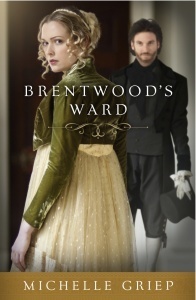 What do you get when you mix a shade of the darker side of Regency London with a quick-witted lawman? Nicholas Brentwood—a hero who’s a little rough around the edges, colorful as a Dickens character, and observant enough to be a forerunner of Sherlock. But he’s not just any lawman . . . He’s a Bow Street Runner.
What do you get when you mix a shade of the darker side of Regency London with a quick-witted lawman? Nicholas Brentwood—a hero who’s a little rough around the edges, colorful as a Dickens character, and observant enough to be a forerunner of Sherlock. But he’s not just any lawman . . . He’s a Bow Street Runner.
Traditionally, male householders in London were expected to police the streets in their neighborhood, and every citizen was to report anyone they witnessed committing a crime. This changed in the eighteenth century because of increasing concerns about the threat of dangerous criminals who were attracted by the growing wealth of London’s middle class.
Prompted by a post-war crime wave in 1749, Magistrate Henry Fielding hired a small group of men to locate and arrest serious offenders. He operated out of No. 4 Bow Street, hence the name “Bow Street Runners.”
Fielding petitioned the government and received funding, but even so, he soon ran out of money to pay these men a worthy salary. Still, the runners were committed to justice, so they took on odd jobs such as watchmen or detectives for hire or even—as in the case of Nicholas Brentwood—guarding people or treasures.
What attracted my interest as an author was an old newspaper advertisement put out by Fielding. It encouraged the public to send a note to Bow Street as soon as any serious crime occurred so that “a set of brave fellows could immediately be dispatched in pursuit of the villains.” I wondered about those “brave fellows” and what kind of villains they might come up against, and thus was born Nicholas Brentwood.
Despite Bow Street’s efforts, most Londoners were opposed to the development of an organized police force. The English tradition of local government was ingrained deep, and they feared the loss of individual liberty. So, as gallant as the Runners were in tracking down criminals, the general public did not always view them in a positive light. Even the nickname given them by the public—Bow Street Runners—was considered derogatory and was a title the officers never used to refer to themselves.
Bow Street eventually gave way to the Metropolitan Police, and by 1839, the Runners were completely disbanded. But that doesn’t mean they don’t live on in the fictional realm. See if you can match wits with an experienced lawman as he tracks down a dangerous criminal in BRENTWOOD’S WARD . . .
There’s none better than NICHOLAS BRENTWOOD at catching the felons who ravage London’s streets, and there’s nothing he loves more than seeing justice carried out—but this time he’s met his match. Beautiful and beguiling EMILY PAYNE is more treacherous than a city full of miscreants and thugs, for she’s a thief of the highest order…she’s stolen his heart.
Available in paperback, ebook, and audiobook formats at Amazon, Barnes and Noble, and other fine booksellers. But even better is that here’s your chance to WIN AN AUDIOBOOK! Hurry, though. This drawing ends tomorrow, April 17th.
CLICK HERE
April 13, 2015
Book recommendation: Minerva’s Marquess

 Camy here! I recently read this oldie-but-goodie from Sheila Walsh and really enjoyed it. It’s not Christian, but it’s clean and a very sweet romance. I tend to really like marriage of convenience romances, so I admit I was a bit biased and ready to like the story because of that plot type. I liked how the heroine was sensible and forthright and willing to take charge of her own life. The hero is also a strong character but not too brooding. And there’s a light mystery thread to keep the story moving at a nice pace.
Camy here! I recently read this oldie-but-goodie from Sheila Walsh and really enjoyed it. It’s not Christian, but it’s clean and a very sweet romance. I tend to really like marriage of convenience romances, so I admit I was a bit biased and ready to like the story because of that plot type. I liked how the heroine was sensible and forthright and willing to take charge of her own life. The hero is also a strong character but not too brooding. And there’s a light mystery thread to keep the story moving at a nice pace.
Here’s the back cover blurb:
The former Miss Minerva Braithwaite thought it a promising proposal when the lord whom she had shamelessly snared into wedlock suggested they go to Paris for their honeymoon. But all too swiftly that promise turned into peril for her hopes of happiness.
First the fearfully handsome, infuriatingly arrogant Lord Dominic Claireux refused to touch her on their wedding journey. Next she discovered that waiting in Paris was the ravishing Lavinia Winterton, who had broken Dominic’s heart once, but who now was eager to make amorous amends.
Somehow the beautiful Minerva had to find a way to melt her husband’s icy reserve and best a hot-blooded rival for his love. And clearly it was going to be a game of enticement and intrigue that only someone as daring as Minerva would gamble on winning…
Anything you’ve read recently that you enjoyed?
April 1, 2015
Make Way for the Postman
Today, the sound of a siren and the flashing red or blue lights make drivers clear the road to make way for the emergency vehicles. They trump all normal road rules because of the importance of their job.
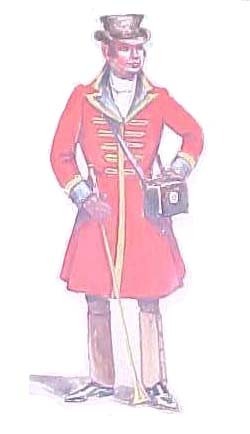
Royal Mail Coach guard in uniform with his clock carrying bag and coaching horn.
In Regency England the road was ruled, not by a siren but by a horn, one carried by the mail coach guard.
This wasn’t the overcrowded stage coach you sometimes hear about. The Royal Mail Coach traveled fast and kept to a very strict schedule, hence the use of the mail coach guard and his horn.
The guards were issued a uniform that looked strikingly similar to the ones used by the military. They were also given guns, a watch, and a very long, tin horn. The watches were all synchronized in London and any variance from the schedule had to be recorded along with the reason for the delay.
Along with providing protection for the coach, the guard would blow the horn. Different tunes meant different things. Some were simply an message to fellow drivers to get out of the way or letting people know they were turning.
But two of the tunes were vital to keeping the mail coach on target.
Royal Mail Coach via Wikimedia Commons
One let postmasters along the route know they were coming. If the coach wasn’t scheduled to stop and change horses or some other necessity, the mail for the town was dropped at the postmaster’s feet while the postmaster tossed up the bag of outgoing mail for the guard to catch.
Another let tollgate operators know the Royal Mail Coach was coming and to open the gate. The mail coach didn’t pay the tolls and didn’t stop at the gates. If the operator didn’t have the gate open in time, he could face a very hefty fine.
Knowing the importance and the power of the horn, it’s no wonder that many of the mail coach guards had their own made out of materials much finer than mere tin.
Though the uniforms have changed and the mail delivery vehicles now have to follow all the rules of the road, the Royal Mail in England is still a very efficient machine. You can see the Top Gear guys try to race a letter across the country in a Porshe here.
March 12, 2015
Poll: How to do you find new Regencies to read?
Camy here! I was having a discussion with a friend about how Regency romance lovers find new Regencies to read.
I usually do it by word of mouth—recommendations from readers on a Goodreads group forum board, or from blogs like this one.
I was curious how you find the new Regencies you read/buy/borrow?
You don’t have to do this, but what I did was go look through my book catalogue database. I use Booxter, which is a Mac program that enables me to enter all the books I’ve read and/or own. I can organize it and search it as I like, which makes it very useful. I went to all the Regency romances I have and sorted it so that I could see the last 10 books I most recently obtained.
Four books were ebooks I bought from Regency authors I already know I enjoy. I get their newsletters and when they had a new Regency available on ebook, I bought it.
Two books were given to me as gifts from a friend who had extra copies of an author’s books.
Two books were free ebooks that I saw advertised somewhere, either on Facebook or BookBub.
The last two books were actually two of three books that I got from Paperbackswap. They are out-of-print Traditional Regency Romances that were published by Signet in the 80s and 90s and are now only available as used paperback copies.
(On a side note, I really wish these old Regencies were available as ebooks! However, I know there’s a lot of factors involved in putting an out-of-print book out in ebook—who owns the rights, if the right-holder has the resources or the time to format the book for e-publishing and get the cover, write the blurb and metadata, upload it to the websites, etc.)
So … how about you? You don’t have to be as exact as I did, but how do you find new Regencies to read and/or buy?
March 9, 2015
Why would I move from London or all of England?
Vanessa here,
Migrations have happened through the ages. So peoples in even during the Regency had wanderlust, a strong desire to see the world. And dare I say it, they even moved beyond the ballrooms of Almack’s. They traveled, they went on holiday, and upon occasion they conquered.
After the Seven-Year War, George Macartney in 1773, talked of the vastness of England’s reach, “the British Empire on which the sun never sets.”
The common attitude of having at least 184 colonies (accumulated from the 1700’s to 1950’s) around the globe supports the concept, making adaptations of the phase very popular:
“The sun never set on the British Flag” (Rev. R. P. Buddicom, 1827)
“The sun never set on British Empire” (Christopher North 1839)
When I study the list of colonies, I believe they are quite right:
Antigua and Barbuda
Dog Island, Gambia
Mombasa
Sabah
Archipelago of San Andrés, Providencia and Santa Catalina
East Jersey
Colony of Natal
Saint Christopher-Nevis-Anguilla
Province of Avalon
Essequibo (colony)
New Brunswick
Saint Kitts and Nevis
Bangladesh
Falkland Islands Dependencies
New England Colonies
Sarawak
Barbados
Fiji
New Hampshire
Crown Colony of Sarawak
Basutoland
Florida
Province of New Hampshire
Sheikhdom of Kuwait
Belize
British Gambia
New Hebrides
Singapore
History of Belize
Gambia Colony and Protectorate
New Jersey
Singapore in the Straits Settlements
Bengkulu
The Gambia
Province of New Jersey
Post-war Singapore
Berbice
Georgia (U.S. state)
New South Wales
South Africa
Bermuda
Province of Georgia
New York
South Australia
Black River (settlement)
Gibraltar
New Zealand
South Carolina
British Honduras
Gilbert and Ellice Islands
Colony of New Zealand
Province of South Carolina
British Bencoolen
Gold Coast (British colony)
Newfoundland and Labrador
South Sudan
Colony of British Columbia (1858–66)
Grenada
Newfoundland Colony
Southern Colonies
Colony of British Columbia (1866–71)
Guadeloupe
Nicobar Islands
Stoddart Island
British Kaffraria
British Guiana
Nigeria
Straits Settlements
British West Indies
Heligoland
Nikumaroro
Sudan
British Western Pacific Territories
Hilton Young Commission
North Australia
Swan River Colony
Brunei
History of West Africa
Crown Colony of North Borneo
Tasmania
Burma
Hong Kong
North Carolina
Colony of Tasmania
British rule in Burma
British Hong Kong
Nova Scotia
Thirteen Colonies
Canada
India
Nyasaland
Tobago
Province of Quebec (1763–91)
Jamaica
Ohio
Tokelau
Province of Canada
Colony of Jamaica
History of Ohio
Transvaal Colony
The Canadas
Jordan
Ohio Country
Trinidad
Cape Breton Island
Kunta Kinteh Island
Operation Sunrise (Nyasaland)
Trinidad and Tobago
Cape Colony
Crown Colony of Labuan
Orange River Colony
United States
Province of Carolina
Lagos
Orange River Sovereignty
Historic regions of the United States
Carriacou and Petite Martinique
Lagos Colony
Pakistan
Upper Canada
British Ceylon
Lakshadweep
Territory of Papua
Van Diemen’s Land
Chesapeake Colonies
British Leeward Islands
Pennsylvania
Colony of Vancouver Island
Chopawamsic
Lower Canada
Province of Pennsylvania
Victoria (Australia)
Colonial Nigeria
Maine
Plymouth Company
Colony of Virginia
Colonial Fiji
Malabo
Prince Edward Island
Walvis Bay
Côn Đảo
British Malaya
History of Pulicat
Weihai (British Colony)
Connecticut
Malayan Union
Colony of the Queen Charlotte Islands
Wessagusset Colony
Connecticut Colony
Malaysia
Queensland
British West Africa
Cook Islands
Malta
Restoration (Colonies)
West Indies Federation
Cook Islands Federation
Crown Colony of Malta
Colony of Rhode Island and Providence Plantations
West Jersey
Cyprus
Massachusetts
Northern Rhodesia
Western Australia
British Cyprus (1914–1960)
Province of Massachusetts Bay
Colonial history of Southern Rhodesia
Western Samoa Trust Territory
Delaware
Mauritius
Southern Rhodesia
British Windward Islands
Delaware Colony
Middle Colonies
Rivers State
Wituland
Demerara
Minorca
Rodrigues
Zimbabwe
Demerara-Essequibo
Mississippi
Rupert’s Land
Zulu Kingdom
Lately, I have been thinking about the hopes and dreams that sent people on a journey to an unknown world. Was it religious freedom like the Quakers? Could it be the quest of gold or the hope for eternal gold by proselytize a different people? What attitudes did they bring? Did social station withstand the hard work of building a colony timber by timber?
For my birthday (March 13 – shameless plug), my lovely husband bought me two copper engraved maps, one of England (1810) and one of South African (1835). I see stories brewing. Stay tuned.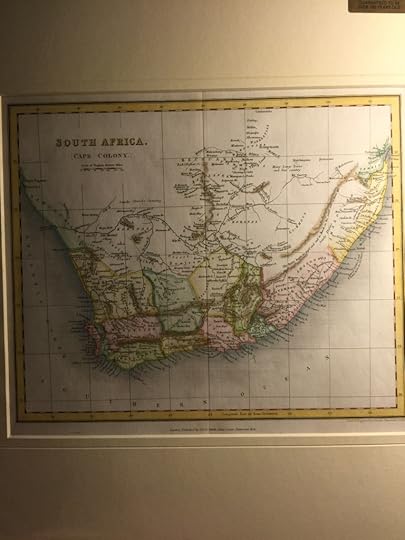
References:
Bartlett, John (1865). Familiar quotations (4th ed.). Boston: Little, Brown and Company. p. 388.
Bacon, Francis (1841). “An Advertisement Touching a Holy War”.
Maritime Enterprise and the Genesis of the British Empire, 1480-1630.
Wikipedia: English Possessions Overseas.
Wikipedia: British Colonization of the Americas.
Wikipedia: British Empire.
March 4, 2015
Miniature Portraits: The Instagram of Regency England
While the first known photograph was taken not long after the Regency period closed, the idea of capturing someone’s likeness was hardly new. Portraits, sketches, and tapestries have existed for many years, giving us glimpses of the history before there were cameras.
Amadeus Mozart and his sister, 1765
But a portrait was time consuming and expensive. Only the very wealthy and important sat for multiple portraits in their lifetimes. It wasn’t uncommon for someone, even of the middle class, to have only one portrait done in a lifetime.
At least, it wasn’t uncommon until the miniature portrait rose to popularity.
Miniature portraits had been around for a long time, but in the late 1700s a new technique was developed that made then sturdier, easier, and even smaller. They were stippled onto ivory backings using tiny dots.
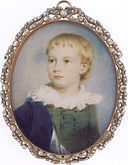 When King George III’s wife wore a miniature portrait of him on her wrist while sitting for a full size portrait of her own, the craze began. Even the middle class got into the game, since smaller portraits required less time and supplies and were therefore considerably less expensive.
When King George III’s wife wore a miniature portrait of him on her wrist while sitting for a full size portrait of her own, the craze began. Even the middle class got into the game, since smaller portraits required less time and supplies and were therefore considerably less expensive.
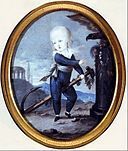 People could even afford to commission portraits of their children and significant events.
People could even afford to commission portraits of their children and significant events.
Royals had several made to give out as tokens to dignitaries and honored friends.
Through the Regency period, multiple painters switched to making their entire livings off of miniature portraits. Ranging from 1 to 7 inches tall, these portraits were used to remember a loved one, whether distant or deceased, commemorate milestones, and as secret tokens of love.
Princess Charlotte’s eye
Close-up miniatures of eyes or even mouths were given as intimate tokens of love, sometimes rather inappropriately. Because a single eye couldn’t be identified as any particular person, the painting could be given in secret, with only the recipient knowing who was really in the picture.
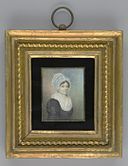 Once painted, the smaller miniatures were set into jewelry, including brooches, necklaces, and bracelets. Larger ones were framed, possibly kept on bedside tables or in other living areas, providing easy access to the beloved images without restraining them to a gallery or significant wall space.
Once painted, the smaller miniatures were set into jewelry, including brooches, necklaces, and bracelets. Larger ones were framed, possibly kept on bedside tables or in other living areas, providing easy access to the beloved images without restraining them to a gallery or significant wall space.
While there aren’t any examples of someone immortalizing their favorite chocolate cake on a brooch, beloved pets or homes were occasionally painted as well.
All pictures obtained from Wikimedia Commons. Click on picture to go to original posting.
March 2, 2015
Didn’t win Brentwood’s Ward? Have some fun making your own Regency hero or heroine!
Congratulations to Merry for winning the drawing for a copy of Brentwood’s Ward! Check your email for more details from Michelle!
While Merry is entertaining herself with the adventures of Nicholas and Emily, the rest of us can have some fun of our own.
I found these really fun links from Deviant Art. It’s virtual Regency paper dolls. The time I spent playing around on this site could be why this post is late this morning… oh well.
Here’s the Regency couple I made:
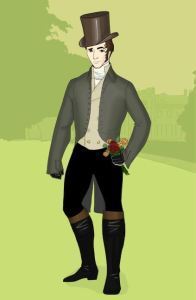
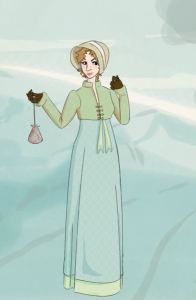
Aren’t they adorable?
You can make your own Regency couple at the links below.
Unfortunately there isn’t a way to post pictures in the comments, but if you make a character and post it elsewhere (Twitter, Pinterest, Facebook, Tumblr, etc.), please leave the link below. We’d love to see them!
Technical Directions for saving the picture:
On a PC running Windows 7 or higher, go to the Start menu and search for the “Snipping Tool”. Select new and drag a square around your picture. Then save it.
I don’t have a Mac, but the internet says you can do something similar in OSX by pressing command + shift + 4.
If these methods don’t work for you, search the internet for how to do a screen capture on your operating system. If you end up with the entire screen, you can go to pic monkey to crop it. (Select edit, load your picture, then select crop. Save your picture to your computer.)

